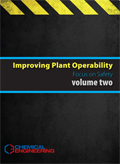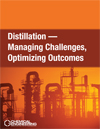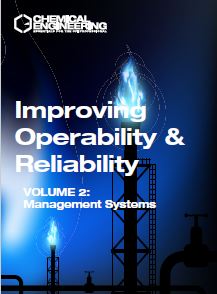Description
Volume two of this two-part guidebook contains practical, how-to engineering articles, and engineering tip sheets from the “Facts at Your Fingertips.” All were originally published in Chemical Engineering. Since safety is key in all chemical process plants, this volume provides many useful engineering recommendations for improving safety in all aspects of plant operation and maintenance.
This guidebook gives broad, plant-wide recommendations for improving plant safety and reducing risk to personnel, plant operation and the environment. There is focus on specific engineering topics including proper monitoring and control of high temperatures, managing static electricity, reducing fire and explosion risk, reducing risks in laboratories, proper waste-handling procedures, selection guidance for personnel-protective gear, reducing the risk of dust explosions, managing MSDSs, proper chemicals-handling techniques and more. Focus is on specific engineering components, such as rotating machinery, vacuum systems, burners and flares.
201 pages, delivered in a PDF format
Table of Contents
Tolerable Risk
While determined risk is generally well understood, tolerable risk can be the missing link to complete risk assessments
Chemical Lifecycle Management
Sustainability demands a higher level of oversight that seeks new ways to effectively and cost efficiently procure, handle and dispose of, or recycle materials
Hearing Protection For CPI Workers
As statistics on rising rates of noise-induced hearing loss in the workplace show, a hearing-conservation program alone is not enough. Workers must understand the risks, have access to hearing protection and, most importantly, use it
Designing for a Safe Process
Incorporating safety considerations throughout process design lowers the risk of a hazardous event
Heat Transfer Fluid Leaks: Break the Fire Triangle
Extreme processing temperatures present the greatest risk. Know where leaks are most likely to occur and
how to prevent them
Avoiding Static Sparks in Hazardous Atmospheres
Relatively simple steps can be taken to mitigate risks associated with static electricity in process plants
A Checklist for Safer Chemical Batch Reactions
A good understanding of the reaction chemistry is needed for a safe process design
A Safety-Centered Approach to Industrial Lighting
The proper design and operation of lighting is essential to ensure plant safety and support good maintenance practices
Designing Safer Process Plants
Several often-overlooked strategies to increase inherent safety are discussed here
A Safety Checklist for Laboratories
These nine best practices for managing change in laboratories can help ensure a safe workplace
Engineering for Plant Safety
Early process-hazards analyses can lead to potential cost savings in project and plant operations
Chemical Lifecycle Management
Sustainability demands a higher level of oversight that seeks new ways to effectively and cost efficiently procure, handle and dispose of, or recycle materials
Clearing the Air About Respiratory Protection
Learn the basics about selection and regulatory compliance for these potentially life-saving devices
Fire-Water Pumps for CPI Facilities
Follow this guidance to improve the selection, design and operation of pumps handling water for firefighting and related systems
Eye-and-Face Personal Protective Equipment
Protecting the eyes and face in the workplace is imperative to preventing the estimated 10–20% of workrelated eye injuries that result in temporary or permanent vision loss
Managing Compliant MSDSs and Labels
Compliant MSDS programs depend on inventory management, regulatory knowledge and consistent authoring
Effective Plant Safety Management
Three critical junctures and seven critical steps for plant safety are outlined
Remote Thermal Sensing
By making it easy to detect heat anomalies, thermal cameras and infrared thermometers support preventive and predictive maintenance
Finding the Right Gloves to Fit the Application
There is a wide range of gloves available for hand protection on the job. Matching gloves to their chemicalresistance properties is one criterion for selection
Dust Control in the Chemical Processing Industries
The prevention of dust hazards in the CPI is integral to process-safety management — wide-reaching mitigation schemes must be implemented
The Integral Role of Waste Management in Capital Projects
To avoid unnecessary efforts and mitigate risks, all phases throughout the design and implementation of large capital projects should incorporate comprehensive planning for waste management
Why Bad Things Happen to Good Steam Equipment
Accounting for an entire steam-trap population is crucial to avoiding safety incidents and suboptimal production — high-priority consideration must be given to steam-system management
Rotating Machinery: What You Should Know About Operational Problems
Follow this guidance to improve the operation, safety and reliability of rotating machinery in chemical process plants
Chemical Protective Clothing
ISO 16602 offers a much-needed, common global language for expressing protective clothing performance
Technology Profile: Propylene Production via Metathesis
Preventing Fires and Explosions in Pilot Plants
The issues and complications are different from — and in many ways more challenging than — those for full-scale plants
Fire & Gas in Safety Systems
Integrating fire-and-gas detectors and mitigation systems into overall process safety control can help ensure fast responses to emergencies
Anti-surge Valves for Dynamic Compressors
Follow this guidance to improve the selection and sizing of anti-surge valves for axial and centrifugal compressors
Preventing Dust Explosions
Risk management programs are critical for safe handling and processing of combustible dust as well as for OSHA regulatory compliance




